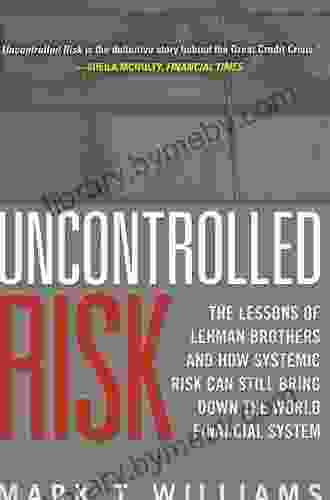Lessons of Lehman Brothers and the Unwavering Menace of Systemic Risk

The catastrophic collapse of Lehman Brothers in 2008 marked a watershed moment in the global financial landscape, exposing the profound vulnerabilities of the interconnected financial system. As the largest bankruptcy in U.S. history, Lehman's demise sent shockwaves through markets worldwide, triggering a financial crisis that nearly plunged the global economy into a second Great Depression.
4.5 out of 5
| Language | : | English |
| File size | : | 809 KB |
| Text-to-Speech | : | Enabled |
| Enhanced typesetting | : | Enabled |
| Word Wise | : | Enabled |
| Print length | : | 256 pages |
| Paperback | : | 368 pages |
| Item Weight | : | 14.8 ounces |
| Dimensions | : | 5.3 x 0.8 x 8.45 inches |
| Screen Reader | : | Supported |
In the aftermath of this financial cataclysm, policymakers, economists, and financial experts have dedicated tireless efforts to understanding the factors that led to Lehman's collapse and the broader systemic risks it exposed. This article delves into the key lessons learned from this pivotal event, highlighting the enduring threat of systemic risk and its potential to bring down the world.
Unraveling the Triggers of Lehman's Collapse
The collapse of Lehman Brothers was a multifaceted event, driven by a complex interplay of factors, including:
- Excessive Risk-Taking: Lehman engaged in aggressive risk-taking, particularly in the subprime mortgage market, which proved to be a ticking time bomb.
- Lax Lending Standards: As the housing market boomed, lenders, including Lehman, lowered lending standards, approving mortgages for borrowers with poor credit histories and limited financial means.
- Securitization of Subprime Loans: Lehman played a significant role in securitizing subprime mortgages, repackaging them into complex financial instruments and selling them to investors as AAA-rated securities, despite their inherent risks.
- Overleveraging: Lehman's excessive use of leverage, borrowing money to amplify its investment potential, compounded its vulnerability to market downturns.
- Lack of Regulatory Oversight: The regulatory framework at the time failed to adequately address the risks posed by complex financial instruments and systemic interconnectedness.
The Contagious Nature of Systemic Risk
The collapse of Lehman Brothers was not an isolated event. Its interconnectedness with other financial institutions and the broader financial system led to a domino effect, as its failure triggered a chain reaction of insolvencies and liquidity crises. This phenomenon, known as systemic risk, demonstrates the vulnerability of complex financial systems to the failure of even a single institution.
In the case of Lehman Brothers, its counterparties, including banks, investment funds, and insurance companies, held significant exposure to its complex financial instruments. When Lehman defaulted, these counterparties faced severe losses, leading to a loss of confidence in the financial system as a whole. This erosion of trust led to a credit crunch, as banks became reluctant to lend to each other and to their customers.
Lessons Learned and the Quest for Stability
The global financial crisis and the collapse of Lehman Brothers have taught us profound lessons about the nature of financial risk and the importance of systemic stability. These lessons have informed regulatory reforms and policy initiatives aimed at preventing future crises:
- Enhanced Risk Management: Regulators have implemented stricter risk management frameworks to ensure that financial institutions have robust systems for assessing and managing risks.
- Capital Requirements: Banks are now required to hold higher levels of capital to absorb losses and withstand financial shocks.
- Stress Testing: Regulators conduct regular stress tests to assess the resilience of financial institutions to various scenarios, including market downturns.
- Resolution Mechanisms: Governments have established resolution mechanisms to facilitate the Free Downloadly failure of large financial institutions without causing systemic disruptions.
- Improved Financial Oversight: Regulators have expanded their oversight to cover a broader range of financial activities, including complex financial instruments and derivatives.
The Enduring Threat and the Need for Vigilance
While regulatory reforms have been implemented to address systemic risks, it is crucial to recognize that financial systems remain complex and interconnected. The enduring threat of systemic risk requires ongoing vigilance and a commitment to sound risk management practices. Policymakers, regulators, and financial institutions must remain alert to emerging risks and adapt their strategies accordingly.
Just as the collapse of Lehman Brothers exposed the systemic vulnerabilities of the financial system, another event, perhaps unforeseen and in a different guise, could trigger a similar crisis in the future. Continuous monitoring, robust risk management, and global cooperation are essential to safeguard the financial system and prevent future crises from bringing down the world.
The lessons of Lehman Brothers serve as a stark reminder of the devastating consequences of unchecked risk-taking and systemic interconnectedness. The global financial crisis has forced a fundamental reassessment of the nature of financial risk and the importance of stability. While regulatory reforms have been implemented to address systemic risks, ongoing vigilance and a commitment to sound risk management practices are paramount to prevent future crises from bringing down the world.
As we navigate the complexities of the ever-evolving financial landscape, let us remember the lessons of Lehman Brothers and strive for a more resilient and sustainable global financial system that serves the needs of society without jeopardizing its stability.
4.5 out of 5
| Language | : | English |
| File size | : | 809 KB |
| Text-to-Speech | : | Enabled |
| Enhanced typesetting | : | Enabled |
| Word Wise | : | Enabled |
| Print length | : | 256 pages |
| Paperback | : | 368 pages |
| Item Weight | : | 14.8 ounces |
| Dimensions | : | 5.3 x 0.8 x 8.45 inches |
| Screen Reader | : | Supported |
Do you want to contribute by writing guest posts on this blog?
Please contact us and send us a resume of previous articles that you have written.
 Book
Book Novel
Novel Page
Page Chapter
Chapter Text
Text Story
Story Genre
Genre Reader
Reader Library
Library Paperback
Paperback E-book
E-book Magazine
Magazine Newspaper
Newspaper Paragraph
Paragraph Sentence
Sentence Bookmark
Bookmark Shelf
Shelf Glossary
Glossary Bibliography
Bibliography Foreword
Foreword Preface
Preface Synopsis
Synopsis Annotation
Annotation Footnote
Footnote Manuscript
Manuscript Scroll
Scroll Codex
Codex Tome
Tome Bestseller
Bestseller Classics
Classics Library card
Library card Narrative
Narrative Biography
Biography Autobiography
Autobiography Memoir
Memoir Reference
Reference Encyclopedia
Encyclopedia Nick Adams
Nick Adams Mr Tim Steele
Mr Tim Steele Logan Thompson
Logan Thompson Marlynn Jayme Schotland
Marlynn Jayme Schotland Wendy T Behary
Wendy T Behary Randolph Lalonde
Randolph Lalonde Nick Ruiz
Nick Ruiz Tony Le Tissier
Tony Le Tissier Susanne Pilastro
Susanne Pilastro Tom G Palmer
Tom G Palmer Luma Mufleh
Luma Mufleh Thomas Pramendorfer
Thomas Pramendorfer Sarah Jo Brown
Sarah Jo Brown Stephan Martin
Stephan Martin Sarah Jackson
Sarah Jackson Rebecca Jones
Rebecca Jones Sally J Pla
Sally J Pla Michael Holley
Michael Holley P J Nichols
P J Nichols Lauren H Kerstein
Lauren H Kerstein
Light bulbAdvertise smarter! Our strategic ad space ensures maximum exposure. Reserve your spot today!
 Ian McEwanFollow ·13.4k
Ian McEwanFollow ·13.4k Roy BellFollow ·9.3k
Roy BellFollow ·9.3k Richard WrightFollow ·6.6k
Richard WrightFollow ·6.6k Ruben CoxFollow ·19.5k
Ruben CoxFollow ·19.5k Carlos FuentesFollow ·7.9k
Carlos FuentesFollow ·7.9k Virginia WoolfFollow ·4.5k
Virginia WoolfFollow ·4.5k Clarence MitchellFollow ·12.1k
Clarence MitchellFollow ·12.1k Jarrett BlairFollow ·8.4k
Jarrett BlairFollow ·8.4k

 Clay Powell
Clay PowellDiscover the Enigmatic Beauty and Profound Meaning in...
An Exploration of Emptiness, Fulfillment,...

 Brenton Cox
Brenton CoxThe Life and Times of the Woman Who Changed Abortion: The...
Norma McCorvey, the woman known...

 Darius Cox
Darius CoxBest 60 Short Hairstyles For Women With Thick Hair: A...
Embracing the beauty of...

 John Parker
John ParkerThe Healthy Pregnancy Book: Your Essential Guide to a...
Pregnancy is a...
4.5 out of 5
| Language | : | English |
| File size | : | 809 KB |
| Text-to-Speech | : | Enabled |
| Enhanced typesetting | : | Enabled |
| Word Wise | : | Enabled |
| Print length | : | 256 pages |
| Paperback | : | 368 pages |
| Item Weight | : | 14.8 ounces |
| Dimensions | : | 5.3 x 0.8 x 8.45 inches |
| Screen Reader | : | Supported |
















